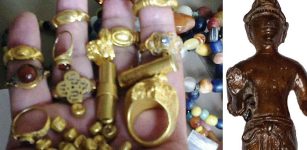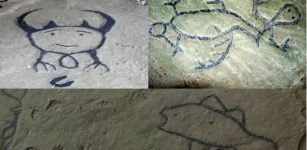The Helgö Treasure: Bronze Buddha Statue, Coptic Scoop And A Crozier Depicting Biblical Tale Of Jonah
A. Sutherland - AncientPages.com - A remarkable collection of religious items from diverse lands was unearthed during archaeological excavations on the Swedish island of Helgö in 1954.
Located in Lake Mälaren (Malaren), west of Stockholm, the island was an important Viking trading and manufacturing center (6th-11th centuries AD. The first archaeological dig uncovered the remains of the early settlement, including a workshop area.
 Helgo Buddha Image credit: Swedish History Museum
Helgo Buddha Image credit: Swedish History Museum
An extensive collection of artifacts –Helgö Treasures - includes Arabic coins, Frankish glass, and metalwork across western Europe. Still, the most notable finds from these excavations included a small Buddha figurine from North India, the Coptic scoop from North Africa dating to the 6th century, and a crozier.
The figure of Buddha is slim, with crossed legs, and he sits on a throne designed as a double lotus flower. His right hand rests on the knee, in the left, which is slightly stretched.
The figurine, probably made in Kashmir, on the Pakistan/India border, had remnants of a narrow leather strap wrapped around the neck and left arm. Something that may indicate that it is stored or buried hanging as a talisman by merchant traders.
Historians hypothesize that the Buddha was carried over thousands of miles, up and down the rivers and across the vast steppes of Eurasia, before arriving at a Viking home in Sweden, perhaps after two or three hundred years of travel.
The Buddha has a silver urn on his forehead, symbolizing the third eye, while the ears have long lobes, symbolizing royalty. He sits in a meditative pose upon a double lotus throne, the latter representing purity, rebirth, and divinity.
The Helgö Crozier
The Helgö crozier is believed to be of Irish (or British) origin.
 A crozier from the island of Helgö, Lake Mälaren, Sweden
A crozier from the island of Helgö, Lake Mälaren, Sweden
The artifact would have formed part of a bishop's staff carried by high-ranking Roman Catholic, Eastern Catholic and Oriental Orthodox, Anglican, and others. Dating about 700-800 AD, the crozier is made of bronze and is decorated with enamel, colored (primarily blue) glass inlays, and has a kind of decorative cut in geometric patterns.
The artifact depicts the biblical tale of Jonah trapped in the mouth of a whale or sea monster. The upper part of the crozier is formed as a winding dragon or a beast. A man's face is also visible between the jaws in the gap. The motif tells the story of Jonah, thrown up from the belly of the animal, symbolizing rebirth.
Although the motif is the same on both sides, the design differs. On one side, the dragon's body (or whalefish) has been given a herringbone-like pattern made in carving. On the other side, the body has been given inlays of small green and yellow enamel pieces.
Even Jonah looks different. He has a forehead and an open, gaping mouth on one side. On the other side, his hairstyle and mouth are different. It has been suggested that one side shows when Jonah is swallowed and the other when the creature vomits him out onto the shore. Why has the artist chosen to do so?
Bronze Coptic Scoop
The third object from the Helgo treasure is a bronze spoon that originates from North Africa, probably in the vicinity of modern-day Egypt. Decorated in minor punch marks, which define a Tree of Life symbol, the artifact was most likely used in ceremonies associated with the early Coptic church.
The scoop consists of a deep bowl and a flat, upright handle. Around the bowl's outer rim and over the handle are decorations of circles, filled triangles, and zick-zack lines.
The bowl's front portion, which is partially damaged, is adorned with plant ornamentation in the form of a so-called life tree.
Written by – A. Sutherland - AncientPages.com Senior Staff Writer
Updated on March 9, 2023
Copyright © AncientPages.com All rights reserved. This material may not be published, broadcast, rewritten or redistributed in whole or part without the express written permission of AncientPages.com
Expand for referencesMore From Ancient Pages
-
 Homo Sapiens In China And What Happened When They Encountered Denisovans Or Neanderthals
Archaeology | Mar 4, 2022
Homo Sapiens In China And What Happened When They Encountered Denisovans Or Neanderthals
Archaeology | Mar 4, 2022 -
 Pharaoh Apries – Was The Betrayed Egyptian King Murdered By His Own People?
Featured Stories | Jun 30, 2021
Pharaoh Apries – Was The Betrayed Egyptian King Murdered By His Own People?
Featured Stories | Jun 30, 2021 -
 Hua Mulan – Chinese Brave Female Warrior In Disguise Who Fought Instead Of Her Old Father
Featured Stories | Sep 30, 2024
Hua Mulan – Chinese Brave Female Warrior In Disguise Who Fought Instead Of Her Old Father
Featured Stories | Sep 30, 2024 -
 Metal Artifacts In Southeast Asia Archaeological Theory – Challenged
Archaeology | Jul 31, 2021
Metal Artifacts In Southeast Asia Archaeological Theory – Challenged
Archaeology | Jul 31, 2021 -
 Why Didn’t Pythagoras And His Followers Eat Beans?
Ancient History Facts | Jan 18, 2019
Why Didn’t Pythagoras And His Followers Eat Beans?
Ancient History Facts | Jan 18, 2019 -
 Fossilized Skulls Reveal Relatives Of Today’s Rhinos Had No Horn And Died Out 5 Million Years Ago
Fossils | Nov 2, 2023
Fossilized Skulls Reveal Relatives Of Today’s Rhinos Had No Horn And Died Out 5 Million Years Ago
Fossils | Nov 2, 2023 -
 Akhenaten: Unorthodox Ruler Who Had Only One God
Featured Stories | Mar 28, 2017
Akhenaten: Unorthodox Ruler Who Had Only One God
Featured Stories | Mar 28, 2017 -
 18th Century Potter Atmospheric Steam Engine Found In Slovakia
Archaeology | Jul 24, 2020
18th Century Potter Atmospheric Steam Engine Found In Slovakia
Archaeology | Jul 24, 2020 -
 Cosmic Message Of The Zapotec Glyphs In The Valley Of Oaxaca – Deciphered!
Archaeology | Mar 10, 2022
Cosmic Message Of The Zapotec Glyphs In The Valley Of Oaxaca – Deciphered!
Archaeology | Mar 10, 2022 -
 Who Is Buried In The Extremely Well-Preserved 2,600-Year-Old Celtic Chamber Tomb Found Near Riedlingen, Germany?
Archaeology | Oct 24, 2024
Who Is Buried In The Extremely Well-Preserved 2,600-Year-Old Celtic Chamber Tomb Found Near Riedlingen, Germany?
Archaeology | Oct 24, 2024 -
 Where Is The Tomb Of Imhotep, Pharaoh Djoser’s Magician Hidden?
Featured Stories | Jun 8, 2021
Where Is The Tomb Of Imhotep, Pharaoh Djoser’s Magician Hidden?
Featured Stories | Jun 8, 2021 -
 Ancient Mesopotamian Discovery Changes Our Understanding Of Early Agriculture Practices
Archaeology | Jan 17, 2022
Ancient Mesopotamian Discovery Changes Our Understanding Of Early Agriculture Practices
Archaeology | Jan 17, 2022 -
 Ancient Wooden ‘Coptic Dolls’ May Have Been The Ancestors Of Today’s Barbie Dolls
Archaeology | Sep 23, 2023
Ancient Wooden ‘Coptic Dolls’ May Have Been The Ancestors Of Today’s Barbie Dolls
Archaeology | Sep 23, 2023 -
 Mysterious Stone Spheres Could Be From Ancient Greek Board Game – Scientists Say
Archaeology | Sep 30, 2022
Mysterious Stone Spheres Could Be From Ancient Greek Board Game – Scientists Say
Archaeology | Sep 30, 2022 -
 Unraveling The Mystery Of How Our Ancestors Created The First Spoken Words
Archaeology | Dec 6, 2021
Unraveling The Mystery Of How Our Ancestors Created The First Spoken Words
Archaeology | Dec 6, 2021 -
 Mystery Of Arthur’s Stone In UK – Solved?
Archaeology | Aug 11, 2021
Mystery Of Arthur’s Stone In UK – Solved?
Archaeology | Aug 11, 2021 -
 New Discovery: Fragments Of Pyramid Dated To 13th Dynasty Discovered In Dahshur Necropolis
Archaeology | Apr 3, 2017
New Discovery: Fragments Of Pyramid Dated To 13th Dynasty Discovered In Dahshur Necropolis
Archaeology | Apr 3, 2017 -
 Porobonus – Mysterious Unknown Pagan God
Artifacts | Aug 28, 2015
Porobonus – Mysterious Unknown Pagan God
Artifacts | Aug 28, 2015 -
 Legendary Lost Island Of Gold Of The Mysteriously Vanished Srivijaya Civilization Found Underwater
Archaeology | Oct 25, 2021
Legendary Lost Island Of Gold Of The Mysteriously Vanished Srivijaya Civilization Found Underwater
Archaeology | Oct 25, 2021 -
 Ancient Mystery Of The Leo Petroglyphs In Ohio Created By An Unknown Native American Culture
Featured Stories | Dec 21, 2020
Ancient Mystery Of The Leo Petroglyphs In Ohio Created By An Unknown Native American Culture
Featured Stories | Dec 21, 2020

